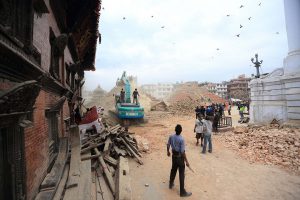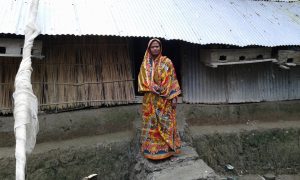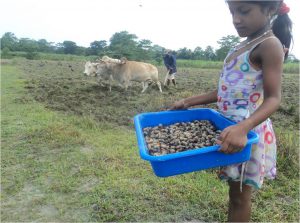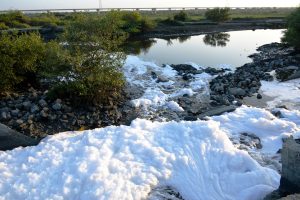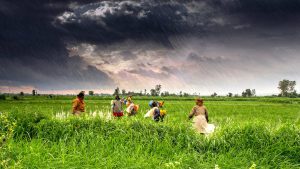A small example of success
People living in the coastal areas of Sindh province in Pakistan, namely district Thatta and Badin, were fully geared to deal with cyclone Nilofar that was predicted to cause damage near the seashore in October 2014. Village and Union Council Disaster Management Committees (VDMCs and UCDMCs) are engaging with local communities in early preparedness and risk mitigation activities to enable them to respond to hazardous situation, such as flood, cyclone and drought since 2012. When cyclone Nilofar was about to strike, these committees helped the villagers coordinate with the district administration on how to respond, including sending timely warnings to vulnerable villages and fishermen out at sea.
These initiatives by Rural Support Programmes Network (RSPN) were undertaken as part of USAID’s community based disaster risk management ‘Tahafuz Project’. A VDMC works at the level of a revenue village – a combination of about two or three villages – a UDMC works at the union council level – which incorporates two or three revenue villages. The National Rural Support Programme (NRSP) and Thardeep Rural Development Programme (TRDP) have provided assistance to them.
![Community members developing hazard map to avoid flood losses in Badin district [image courtesy NRSP]](/wp-content/uploads/2016/08/Community-members-are-developing-hazard-map-to-avoid-flood-losses-during-training-session-at-district-Badin..jpg)
![Rashida, a member of Kharoro Sayed VDMC talking of flood mitigation on Indus FM 95.4 Radio station [image courtesy NRSP]](/wp-content/uploads/2016/08/Rashida-member-VDMC-Kharoro-Sayed-sharing-techniques-tools-with-people-in-local-language-to-save-lives-mitigate-flood-losses-on-local-Indus-FM-95.4-Radio-station-District-Umerkot.jpg)
Pakistan is facing yet another flood situation that has washed away scores of houses in seven villages and standing crops over several hundred acres due to breaches in the dykes of two canals in Ghotki and Badin districts so far. The country is likely to receive 20% more rainfall this year during the monsoons, according to the Met Office. Since the 2010 super floods that affected 21 million people and with recurrent flooding every year in Pakistan, there has been deep criticism about the weak role of the state in reducing flood losses.
Multiple facets of disaster response
People ask why the state machinery is reactive as it acts only after flood waters enter dwellings, kill people and destroy properties. Why can’t the country have a flood early warning system? Why can’t the various disaster management authorities at the federal, provincial and district levels act proactively to protect the lives and assets of ordinary citizens from floods? A recently published research study in an international journal provides some answers.
The study points out the need for seven risk reduction objectives that must be part of any disaster management policy and planning.
These include:
- understanding and communicating the nature of hazards, vulnerabilities and capacities;
- analysing and assessing risks related to those factors;
- addressing the root causes of risks;
- building risk reduction into sustainable development;
- improving livelihood opportunities;
- disaster recovery;
- promoting a safety culture
The study highlights that development is often seen as macroeconomic growth rather than provision of basic services to people and protection of their lives and assets from hazards. With no vision for preparedness, the ten successive five-year plans made over a period of 50 years (1955-2005) continued to focus on technical solutions to disaster. The emphasis remained focused on flooding in the river and canal systems with little attention paid to communicating risks, assessing social vulnerabilities and capacities, or promoting a cultural shift towards disaster risk reduction and management. The 7.6 magnitude earthquake in Northern Pakistan in October 2005 changed all that and proved to be a defining moment in turning around disaster management policy and planning in the country towards a wide range of natural and human induced hazards.
Shortsighted government policies
However, the post-2005 institutional setup of national and provincial disaster management structures have continued to suffer from the institutional entanglement of social, political and economic issues related to institutional hierarchy, population growth, increasing urbanisation, and degradation of the environment. The National Disaster Management Commission (NDMC), the apex body headed by the prime minister, did not hold a meeting for over three years until last year.
![VDMC members at Dai Jarkas rehabilitating a road for emergencies [image courtesy NRSP]](/wp-content/uploads/2016/08/Community-members-of-VDMC-Dai-Jarkas-are-rehabilitating-Earthen-road-for-safe-evacaution-during-emergency-situation-due-to-flooding.jpg)
Disaster governance must be seen as a complex and non-linear phenomenon that involves multiple processes of active coordination and collaboration between different actors and institutions to operationalise policies, strategies and skills to build capacities during all phases of the disaster management cycle in order to minimise the impacts of hazards, save lives, improve livelihoods and protect valuable assets and infrastructure. The government, civil society organisations, communities and community based local institutions such as mosques must act faster than the flood waters to reduce flood losses. It is much more than mere availability of resources that the government
![<p>Villagers from Umerkot practicing shallow water crossing technique [image courtesy RSPN]</p>](https://dialogue.earth/content/uploads/2016/08/Members-from-VDMC-327-are-pratising-the-shallow-water-crossing-technique-to-use-the-same-technique-at-the-time-of-floods-in-District-Umerkot.jpg)
